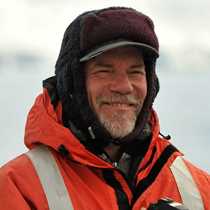Svalbard is an Arctic Archipelago, a group of remote mountainous islands rising from the Barents Sea, only a few hundred miles south of the North Pole. Wide awake through a months-long day and then entombed in an equally long night, swept by polar winds, cold and dry throughout the year, the physical environment on these rocky shores is harsh and unrelenting. Only a few species of land animals have been able to evolve the necessary adaptations to survive here. But the seas around Svalbard, though cold, deep and dark, are fantastically rich with life. Even under the pack ice in winter, the water temperature seldom falls below 30ºF (-1ºC), balmy conditions compared with the terrible cold of the land. Even in the depths of the fjords where the light of the midnight sun never penetrates, a constant rain of organic debris nourishes a community of strange and beautiful animals.
In this Arctic wilderness many of the animals which do survive on the land depend on the sea, either directly or indirectly, for their living. With no small mammals to prey upon, arctic fox and predatory birds like the glaucous-winged gull feed mostly on seabirds, which in turn take their nourishment from fish, plankton and bottom-dwelling invertebrates. Guano from seabird colonies also fertilizes the richest plant communities in Svalbard, the emerald green ornithogenic (bird-generated) meadows, which spill down the slopes below the nesting cliffs. And, of course, the polar bear, undisputed king of the Arctic, is truly a marine mammal. At home on the frozen ocean, dozens or hundreds of miles from land, ice bears feed primarily on seals with an occasional snack of tern eggs.
Using the expedition technology on the Endeavour, we are able to look into these living seas in a way which is available to very few visitors to the Arctic, even scientists who have spent years investigating these waters. Where researchers have only been able to sample remotely using dredges, the camera on our Remote-Operated Vehicle reveals never-before-seen vistas in the dark world at the bottom of the fjords. Even familiar animals in shallower waters may be much better understood by observing them while SCUBA-diving and filming them with a handheld camera. The creature pictured here is an isopod, a common crustacean which is a well-known resident of soft bottom environments around Svalbard. Usually it feeds from the bottom sediments, but in this case I found it clinging to a bunch of kelp and standing up into the current where it was capturing planktonic animals as they drifted by.
Encountering an unusual behavior such as this is perhaps the most exciting of all aspects of diving in the Arctic ocean. The world beneath the surface here is a true frontier, still largely unknown and unexplored. Through the use of our expedition technology on the Endeavour, we can experience the mystery and beauty of the depths and, occasionally, make real contributions toward advancing our knowledge of these rich marine ecosystems.
In this Arctic wilderness many of the animals which do survive on the land depend on the sea, either directly or indirectly, for their living. With no small mammals to prey upon, arctic fox and predatory birds like the glaucous-winged gull feed mostly on seabirds, which in turn take their nourishment from fish, plankton and bottom-dwelling invertebrates. Guano from seabird colonies also fertilizes the richest plant communities in Svalbard, the emerald green ornithogenic (bird-generated) meadows, which spill down the slopes below the nesting cliffs. And, of course, the polar bear, undisputed king of the Arctic, is truly a marine mammal. At home on the frozen ocean, dozens or hundreds of miles from land, ice bears feed primarily on seals with an occasional snack of tern eggs.
Using the expedition technology on the Endeavour, we are able to look into these living seas in a way which is available to very few visitors to the Arctic, even scientists who have spent years investigating these waters. Where researchers have only been able to sample remotely using dredges, the camera on our Remote-Operated Vehicle reveals never-before-seen vistas in the dark world at the bottom of the fjords. Even familiar animals in shallower waters may be much better understood by observing them while SCUBA-diving and filming them with a handheld camera. The creature pictured here is an isopod, a common crustacean which is a well-known resident of soft bottom environments around Svalbard. Usually it feeds from the bottom sediments, but in this case I found it clinging to a bunch of kelp and standing up into the current where it was capturing planktonic animals as they drifted by.
Encountering an unusual behavior such as this is perhaps the most exciting of all aspects of diving in the Arctic ocean. The world beneath the surface here is a true frontier, still largely unknown and unexplored. Through the use of our expedition technology on the Endeavour, we can experience the mystery and beauty of the depths and, occasionally, make real contributions toward advancing our knowledge of these rich marine ecosystems.




